[Toward the end of September 2021 I received an email from one Dr. Dennis Low, a London-based photographer and researcher on the niche subject of historic zoo photography.
Dr. Low contacted me because I serve on the advisory board of the European Society for the History of Photography (ESHPh), with which he found himself in contention over an article recently published in its semiannual journal, PhotoResearcher. Dr. Low had drafted an extensive response thereto, which the ESHPh had refused to publish. Given my connection to the organization, he asked, how would I suggest he proceed?

ESHPh logo
I concluded that I could best serve the interests of Dr. Low, the ESHPh, and “the discourse” on photography by making space available here at Photocritic International for him to present his argument in full. (Click here to download a PDF of the original article to which he responds.)
Due to its length, I have divided Dr. Low’s paper into installments. Part 2 appears below. Click here for Part 1, and here for part 3, here for part 4, and here for part 5. When the series concludes, a PDF download of his complete article will become available. — A.D.C.]
•
A Reply to Moritz Neumüller’s ‘”A Stone Thrown At My Head”:
London by Gian Butturini — A Reception History, 1969-2021′ (b)
by Dennis Low
… For all of Moritz Neumüller’s profuse claims of impartiality and critical objectivity, the very notion that Gian Butturini’s book had not only offended, but offended widely – indeed, globally – remains an untested one, founded not upon documentary evidence, but on faith, or magical thinking, alone. ‘I genuinely believe’, he writes, ‘that the juxtaposition “horrified”, “appalled”, “disgusted” and “outraged” many, in a debate involving the photographic community in the UK, the US, and other Western countries, and to a lesser extent, in India, China, Russia and Latin America’ (2021, p.153, my emphasis).
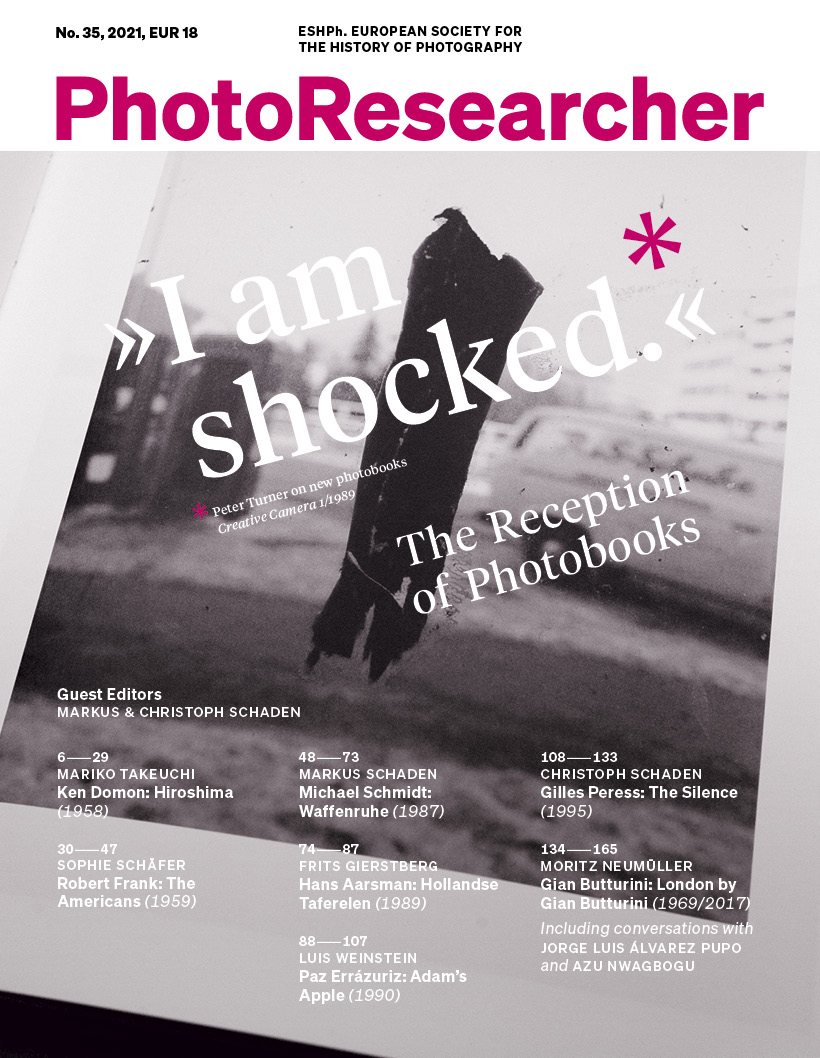
PhotoResearcher, Issue 35 (2021), cover
Conversely, if Butturini’s detractors had to, somehow, be augmented, contorted, and marshalled into the semblance of a coherent argument, that could, subsequently, be used in some kind of ideological balloon debate, Butturini’s supporters, consisting of international academics, gallerists, and respected journalists from national newspapers across Europe, not to mention the Butturini estate itself, had to be curtailed or declawed.
Neumüller’s principal strategy when it comes to this is heavily reliant on careful elisions of his article’s subtitle, ‘A Reception History, 1969-2021’. Far from delivering the ‘full historic perspective’ that, promised early on, encompasses ‘the reception and discussion of the book, between late 1969 and early 2021, in an academic discourse’ (2021, p.137), Neumüller erases key parts of that chronology. In fact, his first erasure constitutes almost the entire chronology, from circa 1970, when London won the Premio EPOCA Diaframma 22 prize (2021, p.140), to circa 2014 and the publication of Martin Parr and Gerry Badger’s The Photobook: A History, Volume III, in which it is featured (2021, p.140).
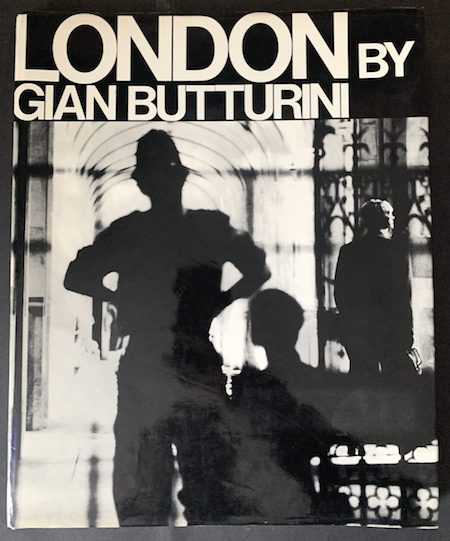
Gian Butturini, London (1969), cover
Neumüller asserts that, soon after its publication in 1969, Butturini’s London ‘became a cult book, recognized for its rough and provocative style, and its highly political content’ (2021, p.135). A few pages on, however, he suggests that, shortly after publication, ‘London by Gian Butturini soon became a rarity and was little known internationally, until it entered volume III of Parr/Badger’s photobook anthology’ (2021, p.141). [See Part 1 for details of this book’s distribution and availability in both its editions. — Ed.] If most of its history is as a ‘cult book’, Neumüller’s readers are never privy to that history: he never describes who the book’s collectors are; what his sources are for their recognizing its ‘provocative style’ and ‘political content’; and what sustains their interest, for almost four decades, until Parr and Badger bring it wider attention by including it in The Photobook.
•
Neumüller’s second erasure is a contemporary one. In contrast to his delicate picking over of individual tweets from the “Less Than Human” / @LTHDebate account on Twitter, Neumüller frankly seems uninterested in London’s reception in Italy from 2020 onwards. He mentions ‘several discussions’; ‘an exhibition called Save the Book’; and how this exhibition, on its own, resulted in ‘around 70 news items, both in digital and traditional media’, including ‘larger newspapers such as La Repubblica, and the Corriere della Sera’ (2021, p.157). All of this is hurriedly dispatched, in barely half a paragraph, unceremoniously handicapped to make for a fairer fight when pitted against the non-existent argument of the tiny anti-Butturini mob.

Neumüller’s dogged determination to achieve a seemingly balanced article doesn’t stop here, and his interventions soon become ever more brazen. On no less than three occasions, for example, does Neumüller raise the question of whether Butturini’s contemporary audiences would have understood his book as racist.
It’s a useful question: racial slurs, like any aspect of culture and language, are geographically, historically, and culturally specific. Twice, Neumüller cuts the difference: ‘[…] to contemporary Italian viewers, the simianisation trope might not have been instantly recognizable or a binding interpretation for this spread in the London book’, he writes, ‘This does not mean, of course, that other readers and the author himself were not aware of the racist trope’ (2021, p.141).
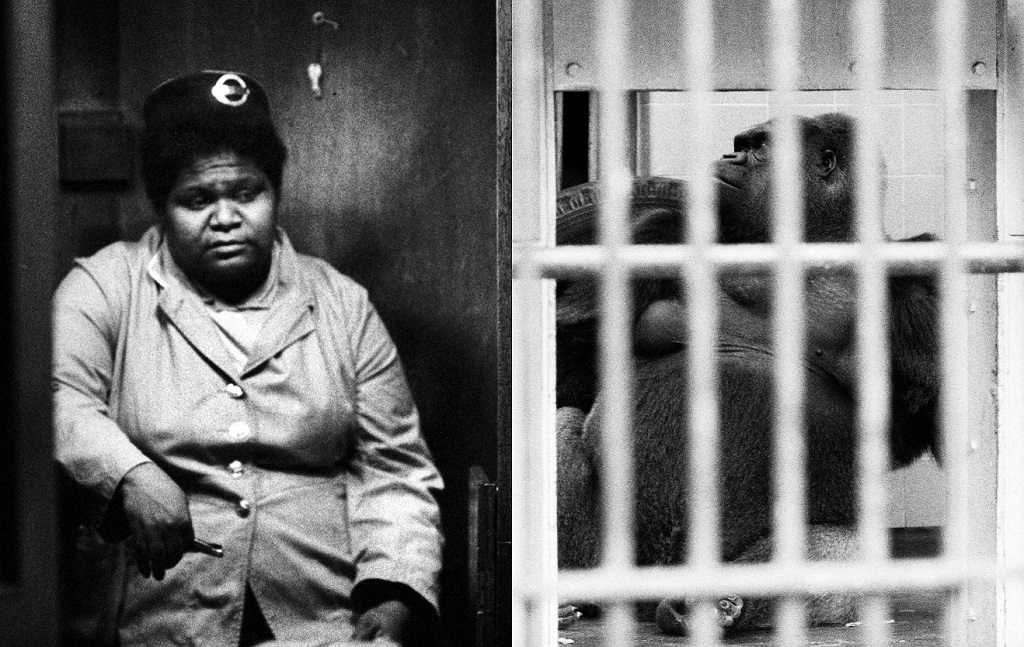
Gian Butturini, London (1969), spread
•
Later, reading Victor Burgin on Garry Winogrand, he again asks: ‘Do we have to find binding proof that the Italian (and British) public of the late 1960s would not have understood the aping trope?’ (2021, p.161) Neumüller’s is, at this point, a topsy-turvy and wilful logic, one that demands conclusive but impossible proof of something not existing, rather than leveraging reasonable and documented proof to the contrary.
If such proof existed, it would be a simple enough matter for Neumüller to find contemporaneous uses of the ‘racist shit’ Butturini was accused of channelling in his photography, whether that be in the form of newspapers, satirical cartoons, joke books, police reports, academic studies or reports on racism – European, late-1960s equivalents of the North American material so carefully and importantly archived in Michigan’s Jim Crow Museum of Racist Memorabilia.
•
And, yet, unable, or unwilling, to even begin to show that simianisation tropes directed at black people were circulated and commonly understood in Italy and/or Britain circa 1969, Neumüller reaches an impasse that can only be overcome by misdirection. In order to maintain the possibility that Butturini knew the trope that this spread in London allegedly replicates, Neumüller outsources research on the subject to an expert, before, in an apparently inexplicable move, relegating that same expert to his thirty-second footnote:
According to Stefania Ragusa, a specialist in African Culture from the University of Parma, discrimination in these years was mainly aimed at Roma, Sinti and Caminanti, as well as Jews, and the inhabitants of the southern part of Italy. She notes that “many Africans who came to Italy in the 70s / 80s of the last century, often for study reasons, say they felt then the object of curiosity rather than racism. Things began to change in the late 1980s, when migration to Italy intensified”. (2021, p.148n)
Stefania Ragusa’s comments certainly begin to offer a counterpoint to Nwagbogu’s unfounded assertion that ‘Butturini was 100 % aware of this and the danger of aping blackness’ (2021, p.162). But, shoehorned into a small-print footnote, rather than highlighted on a separate and differently coloured page and given pride of place in the way that Nwagbogu’s interview is, Ragusa’s comments – and, by extension, her critical position and scholarly authority – are necessarily diminished for the illusion of critical balance.
Neumüller’s strategic but somewhat passive-aggressive decision to do this is made all the more evident when the source for Ragusa’s comments is fully considered. Neumüller references the above as coming from a ‘personal email exchange, on 19 January 2021’ (2021, p.148n). From the selected quotation, it presents as a general overview of post-war race relations in Italy. In actuality, however, Ragusa’s email responds, directly, to Neumüller’s repeated quandary regarding ‘proof that the Italian (and British) public of the late 1960s would not have understood the aping trope’ (2021, p.161).
Ragusa’s original email begins:
Hello everybody.
Here is my answer. I can’t know what references Gian Butturini had in his mind when he made his book or if he was familiar with the American debate on racism. I’m sure however that in Italy, in 1969, there was no specific discussion about the use of the word “black” or the racist and discriminatory power of certain images.[1]
In addition to burying her within his vast and unwieldy textual apparatus, Neumüller is also compelled to severely redact Ragusa’s comments, all the while giving absolutely no indication that he is doing so. As I have argued, the absence of argument from Butturini’s detractors necessitates this. But, as we will see, there was still more for Neumüller to do. Not only did he need to create an argument for Butturini’s detractors to make his article present as balanced and critical, not only did he have to hamstring a respected academic and journalist writing in support of Butturini by covertly redacting their opinions, but he also had to go so far as to help the detractors conceal their true motivations and identities.
•
In their editorial, the editors of PhotoResearcher give a flavour of what is to come in Neumüller’s article. ‘In late May 2019,’ they write, ‘the renowned British photographer and photobook collector [Martin Parr] suddenly saw himself confronted with an accusation of perpetuating racist tropes when the black student Mercedes Baptiste Halliday posted a tweet drawing attention to a combination of motifs on a double-page spread in the book that she felt were offensive and hurtful’ (2021, p.4).
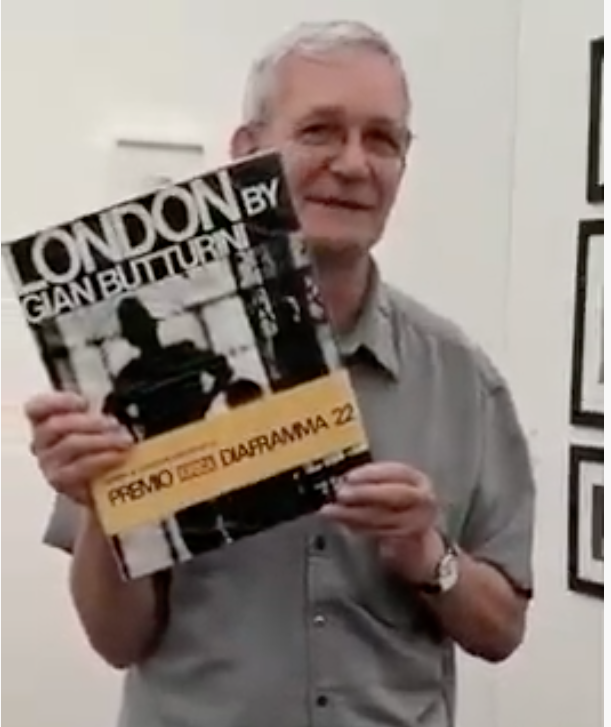
Martin Parr at PhotoLondon 2018 with original LONDON edition, still from video by Butturini Estate
Neumüller picks up and sustains the same narrative, introducing the student as ‘Mercedes Baptiste Halliday, a young woman from Clapham, [who] called on her followers “to confront such vile #racism within #BritishPhotography”’ (2021, p.135); and ‘Mercedes Baptiste Halliday, who started the social media campaign’ (2021, p.157).
Pupo, his interviewee, also picks up the same thread: ‘I also understand that Mercedes (Baptiste Halliday), when she received the book, was upset. I would dare to say that 95 % of black or colored people would be shocked’, he writes, ‘[…] I understand that Mercedes felt offended by the image’ (2021, p.150).
Of course, it is not without reason that the editors of PhotoResearcher, Pupo, and Neumüller himself pursue this Mercedes-focussed narrative. It was, after all, the very story that was reported in the press, both in the UK and abroad. In Neumüller’s article, there is a tacitly held assumption that the press is professional, unbiased and balanced, in the same way that he himself purports to be. In making that assumption, however, Neumüller overlooks – or must wilfully ignore – that not all journalists are created equal in this respect.
Andy Day, senior writer at the photography interest site, Fstoppers, was one of the first journalists to break the news about the allegation of racism levied at Butturini’s London, and Parr’s subsequent resignation from the Bristol Photo Festival. Day reports, simply, that ‘Complaints were first raised in May 2019 by Mercedes Baptiste Halliday, a student who received Butturini’s book as a gift’[2]. The campaign’s spin-doctoring begins here, given that even Paul Halliday’s own tweets confirm the he would ‘never forget the look on my partner’s and daughter’s faces when I showed them #MartinParr’s layout’[3] and ‘bought her another book’[4].
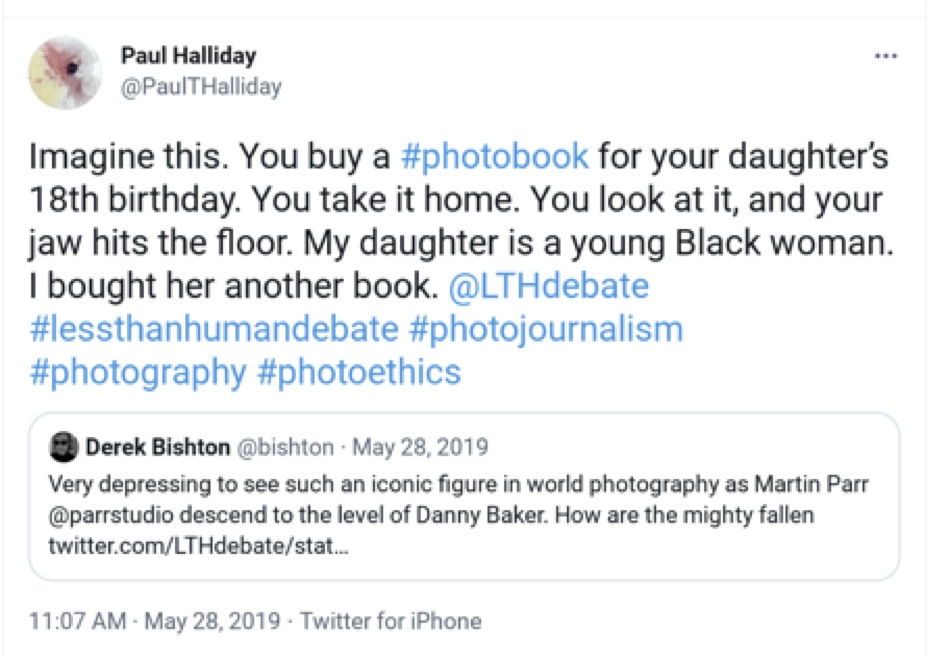
Paul Halliday, Butturini tweet, 5-28-19
It was a point of fact that did not go by unnoticed. Manick Govinda noted that ‘[Mercedes Baptiste] Halliday was reportedly given the book by her father on her 18th birthday’ (my emphasis)[5], something that was soon followed up (without reply) on social media. ‘Can I ask Paul was @manick62 right in his article that you gave the book in question to your daughter?’ asked Rupert Rivett (@rupephoto), ‘And if you did what was the reasoning for you to do that?’[6]
Additionally, what the statement from Day also belies is that Day had been wanting to run the story for more than a year. As the “Less than Human Debate” account (@LTHDebate) debuted on Twitter, he wrote, in reply to their pinned ‘horrified’ and ‘appalled’ tweet, quoted by Neumüller (2021, p.153): ‘Has there been any response from the photographer, the publisher, or Parr? @duckrabbitblog @PaulTHalliday Putting together a short news article for Fstoppers’[7].
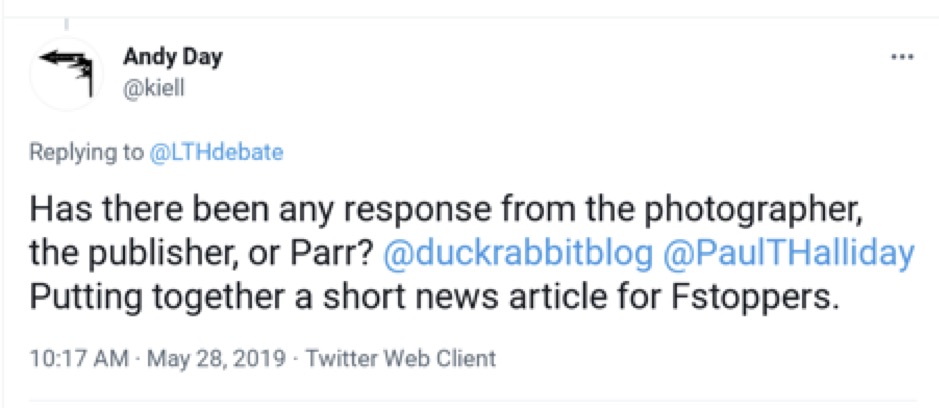
Andy Day, Butturini tweet, 5-28-19
It’s interesting, seeing so many of Butturini’s detractors assembled, so early, in the one tweet – Benjamin Chesterton (@duckrabbitblog); Mercedes’ father, Paul Halliday (@paulthalliday), a photography lecturer at Goldsmiths University; the @LTHDebate account; and Andy Day (@kiell). But, even more interesting is tracing their relationships elsewhere on Twitter. ‘Cobbling an intitial [sic] draft of an article for Fstoppers’ writes Day to Halliday in August 2019, ‘Might send it over to you for some thoughts’[8].
The informal mentorship this tweet hints at is readily unpacked by other exchanges. On one occasion, Halliday tweets: ‘I remember when @kiell was doing his MA Photography & Urban Cultures at @SociologyGold, thinking: “today is Andy day, and I wonder what incredible monuments and buildings he’s going to show us?”’[9]; to which Day replies, ‘Ha! Those were some good times’[10]. In another, Halliday writes, ‘Yes, it’s true Andy – what with your highfalutin ideas around #photoethics and hands-on image-making – what gives you the right to have views on #photography?’[11]; to which Day replies, ‘I guess I need to send back my degree certificate. Let me know your address’[12].
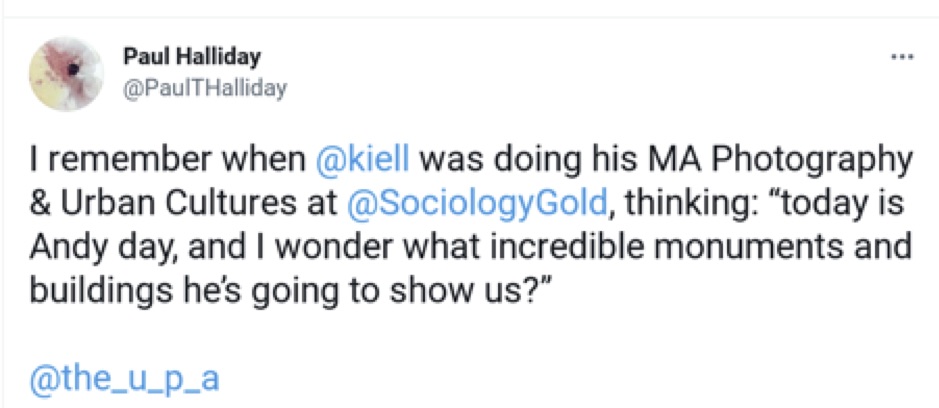
Paul Halliday, Andy Day tweet, 6-12-20
What is also absent, from Day’s piece on Butturini for FStoppers, is any indication, professional disclosure, or otherwise, of Day’s intimate and evidenced relationship with Halliday – his former lecturer and Mercedes’s father – to whom he feels very comfortable sending FStopper article drafts. Day’s silence with regards to this prior relationship proved crucial in the early formulation of the Butturini scandal, because it gave Halliday the opportunity to distance himself from his own campaign, allowing it to run as if it had been the brainchild of a quickly anonymised daughter, who not only played better with the media at the height of Black Lives Matter protests in mid-2020, but was never called upon to present any argument regarding Butturini’s alleged racism.
‘It was a young Black student from London who stood up and challenged this abuse’[13] tweeted Halliday; ‘the Black student who first challenged the gorilla racist trope not only ‘did her research’, but is currently studying anthropology and archaeology in the top rated department in the world’[14]; ‘Seen some reactionary bigots upset that #MartinParr was challenged by a young Black woman’.[15]
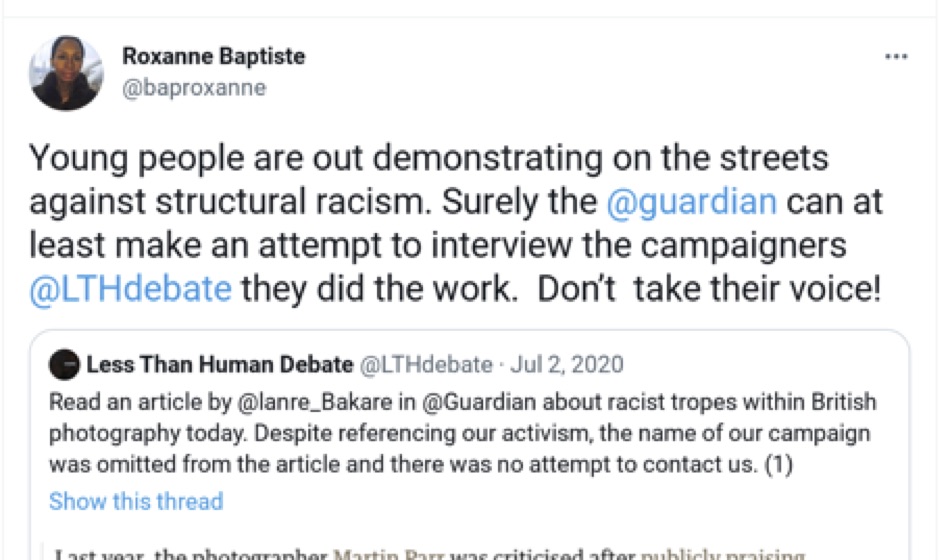
Roxanne Baptiste, Butturini tweet, 7-2-20
Roxanne Baptiste – Mercedes’ mother, Halliday’s partner, and lecturer in media production and Westminster Kingsway College – also chimed in to similar effect, distancing herself from her own, photo-documented involvement as she did so.[16] ‘Young people are out demonstrating on the streets against structural racism’, tweeted Baptiste, ‘Surely the @guardian can at least make an attempt to interview the campaigners @LTHdebate they did the work. Don’t take their voice!’[17] …
•
Notes:
[1] Email from Stefania Ragusa to Moritz Neumüller and Dennis Low, 19 January 2021.
[2] A. Day. (2020). Magnum Photographer Martin Parr Steps Down from Festival Following Outcry Over “Racist” Photobook. [online] Fstoppers. Available at: https://fstoppers.com/documentary/magnum-photographer-martin-parr-removed-festival-following-outcry-over-racist-501809 [Accessed 9 Jun. 2021].
[3] Twitter. (2021). [online] Available at: https://twitter.com/PaulTHalliday/status/1133682146193870848 [Accessed 13 Jun. 2021].
[4] Twitter. (2021). [online] Available at: https://twitter.com/PaulTHalliday/status/1133313778777505792 [Accessed 13 Jun. 2021].
[5] M. Govinda. (2020). The cancellation of Martin Parr. [online] Spiked-online.com. Available at: https://www.spiked-online.com/2020/07/27/the-cancellation-of-martin-parr/ [Accessed 13 Jun. 2021].
[6] Twitter. (2021). [online] Available at: https://twitter.com/rupephoto/status/1288254002048581632 [Accessed 13 Jun. 2021].
[7] Twitter. (2021). [online] Available at: https://twitter.com/kiell/status/1133301162801881088 [Accessed 9 Jun. 2021].
[8] Twitter. (2021). [online] Available at: https://twitter.com/kiell/status/1160891086920921088 [Accessed 9 Jun. 2021].
[9] Twitter. (2021). [online] Available at: https://twitter.com/PaulTHalliday/status/1271510908133609472 [Accessed 9 Jun. 2021].
[10] Twitter. (2021). [online] Available at: https://twitter.com/kiell/status/1271542628270649344 [Accessed 9 Jun. 2021].
[11] Twitter. (2021). [online] Available at: https://twitter.com/PaulTHalliday/status/1227860975505768448 [Accessed 9 Jun. 2021].
[12] Twitter. (2021). [online] Available at: https://twitter.com/kiell/status/1227864836006129664 [Accessed 9 Jun. 2021].
[13] Twitter. (2021). [online] Available at: https://twitter.com/PaulTHalliday/status/1198532479495352320 [Accessed 11 Jun. 2021].
[14] Twitter. (2021). [online] Available at: https://twitter.com/PaulTHalliday/status/1292747735624560645 [Accessed 11 Jun. 2021].
[15] Twitter. (2021). [online] Available at: https://twitter.com/PaulTHalliday/status/1285930414360715264 [Accessed 11 Jun. 2021].
[16] T. Seymour. (2020). Martin Parr steps down as artistic director of Bristol Photo Festival after student’s anti-racism campaign. [online] Theartnewspaper.com. Available at: https://www.theartnewspaper.com/news/martin-parr-stood-down-from-bristol-photo-festival-after-student-anti-racism-campaign [Accessed 11 Jun. 2021].
[17] Twitter. (2021). [online] Available at: https://twitter.com/baproxanne/status/1278789712635977731 [Accessed 11 Jun. 2021].
•
© Copyright 2021 by Dennis Low. All rights reserved. For reprint permissions, other usages, and questions, please contact the author: dennis(at)takemetothekittens(dot)com.






Leave a Comment